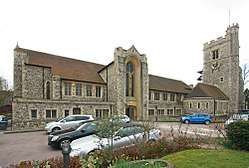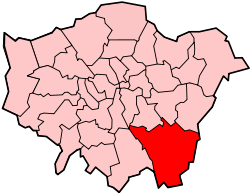Bromley
Bromley is a large town in South East London, England, and the administrative headquarters of the London Borough of Bromley. It is located 9.3 miles (15.0 km) south-east of Charing Cross, the traditional centre of London.[2] It had a population of 87,889 as of 2011.[3] It is identified in the London Plan as one of the 13 metropolitan centres of Greater London.[4]
| Bromley | |
|---|---|
 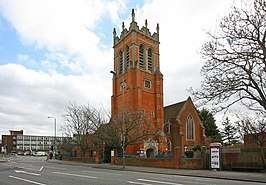 From top to bottom: High Street, Bromley; St Mark's Church on Westmoreland Road | |
 Bromley Location within Greater London | |
| Population | 87,889 [1] |
| OS grid reference | TQ405695 |
| • Charing Cross | 9.3 mi (15.0 km) NW |
| London borough | |
| Ceremonial county | Greater London |
| Region | |
| Country | England |
| Sovereign state | United Kingdom |
| Post town | BROMLEY |
| Postcode district | BR1, BR2 |
| Dialling code | 020 |
| Police | Metropolitan |
| Fire | London |
| Ambulance | London |
| UK Parliament | |
| London Assembly | |
Historically a market town, chartered in 1158, Bromley was an ancient parish in the county of Kent.[5] Its location on a coaching route and the opening of a railway station in 1858 were key to its development, and the shift from an agrarian village to commerce and retail. As part of the suburban growth of London in the 20th century, Bromley significantly increased in population and was incorporated as a municipal borough in 1903. Part of Greater London since 1965,[4] Bromley today forms a major retail and commercial centre.[6]
History
Bromley is first recorded in a charter of 862 as Bromleag and means 'woodland clearing where broom grows'. It shares this Old English etymology with Great Bromley in Essex, but not with the Bromley in Tower Hamlets.[7]
The history of Bromley is closely connected with the See of Rochester. In AD 862 Ethelbert, the King of Kent, granted land to form the Manor of Bromley. It was held by the Bishops of Rochester until 1845, when Coles Child, a wealthy local merchant and philanthropist, purchased Bromley Palace (now the hub of the Bromley Civic Centre) and became lord of the manor. The town was an important coaching stop on the way to Hastings from London, and the now defunct Royal Bell Hotel (just off Market Square) is referred to in Jane Austen's Pride and Prejudice. It was a quiet rural village until the arrival of the railway in 1858 in Shortlands, which led to rapid growth, and outlying suburban districts such as Bickley (which later overflowed into Bromley Common) were developed to accommodate those wishing to live so conveniently close to London.[8]
Bromley, also known as Bromley St Peter and St Paul, formed an ancient parish in the Bromley and Beckenham hundred and the Sutton-at-Hone lathe of Kent.[9] In 1840 it became part of the expanded Metropolitan Police District. The parish adopted the Local Government Act 1858 and a local board was formed in 1867. The board was reconstituted as Bromley Urban District Council in 1894 and the parish became Bromley Urban District. It formed part of the London Traffic Area from 1924 and the London Passenger Transport Area from 1933.[10] In 1934, as part of a county review order, the borough was expanded by taking in 1,894 acres (7.66 km2) from the disbanded Bromley Rural District; an area including parts of the parishes of Farnborough, Hayes, Keston and West Wickham. Bromley became part of the newly created Greater London in 1965, in the new London Borough of Bromley.
Governance
Bromley forms part of the Bromley and Chislehurst Parliament constituency. The current MP is Bob Neill. Gareth Bacon is the London Assembly member for the Bexley and Bromley constituency, in which the town is located.
Bromley's most prominent MP was the former Conservative Prime Minister Harold Macmillan.
Climate
Climate in this area has mild differences between highs and lows. The Köppen Climate Classification subtype for this climate is "Cfb". (Marine West Coast Climate/Oceanic climate).[12]
Economy
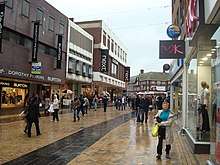
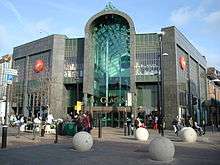
Bromley is one of the major metropolitan centres identified in the London Plan.[13] Bromley has one of the highest gross disposable household incomes (GDHI) in the UK, at £27,169 in 2018.[14]
Bromley was ranked 4th in London by Retail Footprint in 2005, behind the West End, Croydon and Kingston upon Thames.[15] Bromley competes with both Croydon and the Bluewater centre in Dartford as a shopping destination.[16]
Bromley High Street
The town has a large retail area, including a pedestrianised High Street and The Glades centre, the main shopping mall, which has a catchment of 1.3 million people.[17] The shopping area includes retailers such as Gap, Oasis, Russell & Bromley and Waterstone's, whilst the restaurants includes a branch of the small chain of Belgian-themed Belgo restaurants. Development at the nearby St. Mark's Square has seen further restaurants and a cinema established.
Bromley High Street is also the location for the Bromley Charter Market, which runs on a Tuesday, Thursday and Saturday. King John granted a charter for the Market to be held every Tuesday in 1205, with Henry VI revising this charter to every Thursday in 1447.[18][19] The Market sells food and confectionery items, clothing and other goods like jewellery.
Transport
Rail
Bromley South station is served by Southeastern services to London Victoria (non stop express services, semi fast services via Denmark Hill and stopping services via Herne Hill), Kentish Town via Catford and London Blackfriars, Orpington, Sevenoaks via Swanley, Ramsgate via Chatham, Dover Priory via Chatham & Canterbury East and Canterbury West via Maidstone East & Ashford International. Bromley North station also connects the town with Southeastern shuttle services to Grove Park, where connections can be made for services to London Charing Cross & London Cannon Street via Lewisham.
Buses
Bromley is served by London Buses routes 61, 119, 126, 138, 146, 162, 208, 227, 246, 261, 269, 314, 320, 336, 352, 354, 358, 367, N3 & N199. These connect it with areas including Beckenham, Bexleyheath, Biggin Hill, Catford, Chislehurst, Croydon, Crystal Palace, Eltham, Grove Park, Lewisham, Mottingham, New Addington, Orpington, Penge, Sidcup, West Wickham & Westerham.
Culture
Theatres
Bromley has a number of theatres in the borough, in the town centre there are two, a professional, the Churchill Theatre and an amateur, the Bromley Little Theatre close to Bromley North railway station.
The Churchill
The Theatre was opened on 19 July 1977 by the Prince of Wales, and seats 781. It is run on a contract currently held by HQ Theatres Ltd acting as both a receiving and producing house, with productions transferring to the West End or touring nationally. An example being recent tours of Club Tropicana The Musical.
Library
Bromley also has a central library in the same building as the Churchill Theatre with a large book stock, Internet and wifi access, reference library and local studies department. It functions as the central library of the broader Bromley Borough Libraries Service.
Cinema
- Bromley Picturehouse was opened in June 2019 in the previous Odeon theatre.
- Vue Cinemas own a nine-screen cinema, which is part of the Bromley South Central scheme at St Mark's Square, opened on 28 November 2018.[20]
Dance
Bromley has its own team of Morris dancers, The Ravensbourne Morris Men founded in 1947 as a post war revival team following an inaugural meeting at the then Jean's Café, which was located opposite Bromley South Station.[21]
Popular culture
In the famous Monty Python Spam sketch Bromley was stated to be the location of the fictional Green Midget Café, where every item on the menu was composed of spam in varying degrees. In another Monty Python sketch, it was stated that all seven continents are visible from the top of the Kentish Times building in Bromley.
The Mall in Bromley appeared on the cover of the 1982 album Sounds Like Bromley by Bromley born Billy Jenkins. The picture is of the rear of the then Bromley Toy Fayre, Bramber Womenswear and car park above a supermarket.
The Bromley Contingent was the name given to the entourage that followed the Sex Pistols and helped popularise the punk movement. It was so called because many of its members were from Bromley, some of whom later became famous as musicians in their own right, like Siouxsie Sioux and Billy Idol.
In 2003, Bromley held the first edition of the European Quizzing Championships won by the Belgian team 'Café Den Hemel'
In the American TV series GLOW, Rhonda Richardson is played by British singer Kate Nash. During the series, she informs us that she left her drunk and abusive parents in Bromley, in order to both make it as a singer and wrestler.
The X Factor winner of 2016, Matt Terry, performed in Bromley in the town centre (his hometown) on 7 December. He sang on stage outside the Glades shopping centre, with Nicole Scherzinger by his side, as part of the homecoming gigs contestants embark on ahead of the final.
The 2018 humorous film, The Bromley Boys is set in Bromley and surroundings in the late 1960s and early 1970s. Based on a real-life memoir by Dave Roberts about following Bromley F.C., it includes many scenes filmed locally, although Crockenhill F.C. was used as a substitute for the Hayes Lane stadium.[22]
Sport and leisure
The town has four Non-League football clubs. Two teams play their home games at the Hayes Lane Stadium: Bromley F.C. and Cray Wanderers F.C.; the latter is claimed to be the oldest football club in what is today Greater London.[23] The other teams, Holmesdale F.C. and Greenwich Borough F.C., play at Oakley Road. Bromley F.C. are in the Conference National, one level below the Football League.
Four rugby clubs in Bromley are, Old Elthamians a National League 2 side, Parkhouse FC, Bromley RFC and Beckenham RFC. Beccehamians RFC is a club that was founded in 1933 which plays competitive rugby at Sparrows Den at the bottom of Corkscrew Hill in nearby West Wickham.[24]
Education
Bromley has numerous schools, and is home to Bromley College of Further & Higher Education. There are two specialist Media Arts Schools, Hayes School and The Ravensbourne School. Bishop Justus School is a specialist Music College. It also has the Ravens Wood and Darrick Wood Schools. There are many independent schools within the London Borough of Bromley, including Eltham College (in the nearby area of Mottingham – within the borough of Bromley and near the London Borough of Lewisham) and Bromley High (situated in the nearby area of Bickley - also within the borough of Bromley).
Demography
Bromley town as a whole, including its neighbourhoods and villages, is formed of six wards: Bickley; Bromley Common and Keston; Bromley Town; Hayes and Coney Hall; Plaistow and Sundridge; and Shortlands. Together they had a population of 87,889 in the 2011 UK census, whereas the borough overall had a population 331,096.[25]
The life expectancy in Bromley Town ward (which covers the town centre) was 79.3 years for males and 83.7 years for females, during 2009–2013. The highest in the town were in Shortlands: 86.1 years for males and 88.1 years for females. The lowest for both genders was in Plaistow and Sundridge: 77.5 and 82.1 years respectively.[26]
In Bromley Town, 18.5% of the population was of minority ethnicity. The highest in the town was 19.3% in Plaistow and Sundridge, and the lowest was 8.3% in Hayes and Coney Hall.[27]
The median house price in Bromley Town ward was £327,000 in 2014, compared to £295,444 in Plaistow and Sundridge, and £480,000 in Bickley. 37% of houses in Bickley were detached, more than other wards. In all wards, over 60% of houses were owned by households, peaking at 88.2% in Hayes and Coney Hall.[28]
Landmarks
The parish church of St Peter and St Paul stands on Church Road. It was largely destroyed by German bombing on 16 April 1941 and rebuilt in the 1950s incorporating the medieval tower and reusing much of the flint and fragments of the original stone building.[29] The most noteworthy historic building is Bromley College, London Road. The central public open spaces are; Queen's Gardens, Martin's Hill, Church House Gardens, Library Gardens and College Green.
Another parish church in Bromley worth noting is St Mark's, which stands in Westmoreland Road. The present church is the third. The first was built as a temporary iron church in 1884 to cope with Bromley's growing population, on land slightly to the east of the present church, donated by a local man called Eley Soames. The road name St Mark's Road preserves the rough location of the former site.[30] The East Street drill hall was completed in 1872.[31]
The second church was built in brick and stone on the present site, and designed by Evelyn Hellicar, son of the then vicar of St Peter and St Paul's. It was completed in 1898 in the Perpendicular Gothic style and consecrated by William Walsh, Bishop of Dover, on 22 October that year. The tower, though, was not completed until 1904. Like St Peter and St Paul's, St Mark's was heavily damaged in the London Blitz of 1941. Only the tower survived intact.[30]
On 3 June 1952, the Duchess of Kent laid the foundation stone of the present church, which was designed by T W G Grant and built by David Nye. Besides the tower, other parts of the fabric of the original church were used in the rebuilding. Inside there are some interesting monuments: to Samuel Ajayi Crowther, John Cole Patteson and Vedanayagam Samuel Azariah, who were all bishops in the Commonwealth.[30]
Notable residents – past and present
H. G. Wells
H. G. Wells, "one of the remarkable minds of the twentieth century," was born in Bromley on 21 September 1866, to Sarah and Joseph Wells; his father was the founder of the Bromley Cricket Club and the proprietor of a shop that sold cricket equipment.[32] Wells spent the first thirteen years of his life in Bromley. From 1874 to 1879 he attended Tomas Morley's Bromley Academy, at 74 High Street.[33] There was an 'H. G. Wells Centre' in Masons Hill near the southern end of the High Street which housed the Bromley Labour Club (the building was demolished in 2017). In August 2005, the wall honouring Wells in Market Square was repainted. The current wall painting features a rich green background with the same Wells reference and the evolution sequence of Homo sapiens featured in Origin of Species by Charles Darwin, a former resident of nearby Downe Village.[34]
Wells wrote about Bromley in an early unsigned article in the Pall Mall Gazette in which he expressed satisfaction that he had been born in an earlier, more rural Bromley.[35] A blue plaque marks Wells' birthplace in Market Square, on the wall of what is now a Primark store.[36] A marble plaque appears above the door of 8 South Street, the location of Mrs Knott's Dame school where "Bertie", as he was called as a child, learned to read and write.[37] H.G. Wells featured Bromley in two of his novels: The War in the Air (which refers to Bromley as Bunhill) and The New Machiavelli (in which Bromley is referred to as Bromstead).
However, H. G. Wells refused the offered freedom of the town, stating:
"Bromley has not been particularly gracious to me nor I to Bromley and I don't think I want to add the freedom of Bromley to the freedom of the City of London and the freedom of the City of Brussels – both of which I have."
He described Bromley in one of his novels as a "morbid sprawl of population". [38]
Other residents
Owen Chadwick was born in Bromley in 1916. He was awarded the Order of Merit, was Vice Chancellor of University of Cambridge, Master of Selwyn Cambridge, Regius Professor of Modern History, Dixie Professor of Ecclesiastical History, Chancellor of University of Anglia, President of the British Academy, and was a Rugby Union International.
Other world-famous authors who hail from Bromley include Captain W.E. Johns (author of the Biggles adventures), David Nobbs (author of The Fall and Rise of Reginald Perrin and writer for Les Dawson and The Two Ronnies), and Enid Blyton who wrote influential children's fiction such as the Secret Seven and Famous Five stories. A blue historical plaque can be found on the external wall of her former home on Shortlands Road, Bromley.
Other famous people who lived in Bromley include David Bowie, Charles Darwin, Talbot Rothwell, screenwriter of twenty Carry On films, Peter Howitt, Richmal Crompton, Pixie Lott, Matt Terry, Christopher Tennant, Hanif Kureishi, Peter Frampton, Aleister Crowley, bassist Steven Severin of Siouxsie and the Banshees, Fatboy Slim, Jack Dee, Gary Rhodes, Pete Sears, Poly Styrene, singer Billy Idol, Trevor Goddard, actor Billy Jenkins, Alex Clare, cricketer Jill Cruwys,[39] the anarchist Peter Kropotkin,[40] the former Clash drummer Topper Headon, illustrator Charles Keeping, Formula 1 test driver Gary Paffett, IndyCar driver Mike Conway, children's writer Andrew Murray, tenor Roland Cunningham, actor Michael York who attended Bromley Grammar School for Boys,[41] clarinetist Chris Craker, Don Perrin, Canadian author who attended Burnt Ash School in Bromley, and Sir Thomas James Harper, an officer decorated in the Crimean War. The musical conducting brothers Stephen and Nicholas Cleobury were born in Bromley. Actor Jerome Flynn, who starred in Game of Thrones as Bronn, was born in Bromley.
In the 20th century, the Parish Church of St Peter and St Paul produced, in quick succession, three Church of England Bishops: Henry David Halsey – Bishop of Carlisle, Philip Goodrich – Bishop of Worcester, David Bartleet – Bishop of Tonbridge. Sculptor Nicholas Cornwell and Maisy James the Big Brother 12 housemate. Some time before 1881 the engineer and industrialist Richard Porter moved to Beckenham where he remained until his death in 1913. Hanif Kureishi, the writer and filmmaker was born here, and spent a significant part of his youth, here. His first novel The Buddha of Suburbia was loosely based on his life here and the people he lived and met here.
Comedian Frankie Boyle claims to be a former resident and has described Bromley as a 'lobotomy made out of bricks'.[42] The comedian Chris Addison[43] currently lives in Bromley.
West Ham United F.C. midfielder Gary O'Neil, former Everton FC midfielder Tim Cahill, and former Blackburn Rovers striker Jason Roberts lived in Bromley. English darts player Les Capewell was born in Bromley.
Scottish education secretary Michael Russell MSP was born and spent the early years of his life in Bromley.
See also
References
- Bromley is made up of 3 wards in the London Borough of Bromley: Bickley, Bromley Common and Keston, Bromley Town, Hayes and Coney Hall, Plaistow and Sundridge, and Shortlands. "Archived copy". Archived from the original on 22 February 2014. Retrieved 9 June 2014.CS1 maint: archived copy as title (link)
- Mayor of London (February 2008). Greater London Authority https://web.archive.org/web/20121015074107/http://www.london.gov.uk/thelondonplan/images/maps-diagrams/jpg/map-5d-1.jpg. Archived from the original on 15 October 2012. Retrieved 29 September 2009. Missing or empty
|title=(help) - "Archived copy". Archived from the original on 22 February 2014. Retrieved 9 June 2014.CS1 maint: archived copy as title (link)
- Mayor of London (February 2008). "London Plan (Consolidated with Alterations since 2004)" (PDF). Greater London Authority. Archived from the original (PDF) on 2 June 2010. Retrieved 29 September 2009.
- "Bromley CP/AP through time | Census tables with data for the Parish-level Unit". Visionofbritain.org.uk. Retrieved 19 May 2014.
- https://hidden-london.com/gazetteer/bromley/
- Mills, Anthony David (2001). Dictionary of London Place Names. Oxford University Press. ISBN 0-19-280106-6
- "Bromley". Mick Scott, Non such Publishing. 2005. Archived from the original on 9 April 2009.
- Great Britain Historical GIS / University of Portsmouth, Bromley parish. Retrieved 29 September 2009.
- Robson, William (1939). The Government and Mis-government of London. London: Allen & Unwin.
- Geographers A-Z Map Co Ltd, London Postcode and Administrative Boundaries Map, (2008), ISBN 9781843485926
- "Travel Weather Averages (Weatherbase)". Weatherbase.
- Mayor of London (February 2008). "London Plan (Consolidated with Alterations since 2004)" (PDF). Greater London Authority. Archived from the original (PDF) on 2 June 2010.
- "Regional gross disposable household income, UK – Office for National Statistics". www.ons.gov.uk. Retrieved 19 March 2019.
- https://web.archive.org/web/20071020003313/http://www.caci.co.uk/msd.asp?url=lsp-retailfootprint.htm
- https://hidden-london.com/gazetteer/bromley/
- "The Glades, Bromley". Lunson Mitchenall. Retrieved 19 March 2019.
- "Bromley | borough, London, United Kingdom". Encyclopedia Britannica. Retrieved 19 March 2019.
- Admin, Bromley. "Bromley Charter Market". www.bromley.gov.uk. Retrieved 19 March 2019.
- Ballinger, Chris (3 December 2018). "First looks pictures inside new Vue cinema in Bromley". croydonadvertiser. Retrieved 21 June 2020.
- "Ravensbourne Morris – Home side of the World Morris Dancing Record Holder Ben Dauncey". Ravensbourne.org. Archived from the original on 22 January 2013. Retrieved 19 May 2014.
- Bromley Boys Press Kit Accessed 28 January 2020
- https://www.mylondon.news/news/south-london-news/11-reasons-bromley-become-one-15569399
- UK2.NET. "Beccehamian RFC Home Page". www.beccehamians.co.uk.
- "Archived copy". Archived from the original on 22 February 2014. Retrieved 9 June 2014.CS1 maint: archived copy as title (link)
- https://data.london.gov.uk/dataset/ward-profiles-and-atlas
- https://data.london.gov.uk/dataset/ward-profiles-and-atlas
- https://data.london.gov.uk/dataset/ward-profiles-and-atlas
- "St Peter and St Paul website". Archived from the original on 5 February 2009.
- Robin Waldron. "St Mark's History" (PDF) (2011 ed.). St Mark's Church Bromley. Archived from the original (PDF) on 13 July 2014. Retrieved 6 April 2015.
- "Bromley". The drill hall project. Retrieved 23 September 2017.
- David C. Smith, H.G. Wells: Desperately Mortal: A Biography (New Haven and London: Yale University Press, 1986), p. 4.
- David C. Smith, H.G. Wells: Desperately Mortal: A Biography (New Haven and London: Yale University Press, 1986), p. 6.
- Darwin. www.bromley.gov.uk. Archived from the original on 8 January 2009. Retrieved 3 February 2008.
- David C. Smith, H.G. Wells: Desperately Mortal: A Biography (New Haven and London: Yale University Press, 1986), p. 5.
- "The Time Machine Project-Bromley, Kent". colemanzone.com.
- "H G Wells - South Street, Bromley, London, UK - Blue Plaques on Waymarking.com". www.waymarking.com.
- "War of the words: How H G Wells snubbed Bromley". 29 December 2010.
- "Jill Cruwys". Cricinfo.
- "Peter Kropotkin". Bromley Council. Archived from the original on 12 November 2011.
- "Michael York". When We Were Kids. Archived from the original on 9 April 2009. Retrieved 8 April 2009.
- "Frankie Boyle". The Evening Standard. London. 21 March 2012.
- "Chris Addison". The Guardian. London. 26 April 2010.
Further reading
- James Thorne (1876), "Bromley", Handbook to the Environs of London, London: John Murray, hdl:2027/mdp.39015063815669
External links
![]()
.jpg)
